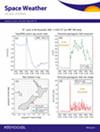Characterization of Scintillation Events With Basis on L1 Transmissions From Geostationary SBAS Satellites
IF 3.7
2区 地球科学
引用次数: 0
Abstract
Signals recorded by two stations in the Brazilian region: [Fortaleza (3.74°S, 38.57°W) and Inconfidentes (22.31°S, 46.32°W)], receiving L1 transmissions from different geostationary satellites, were used to evaluate the amplitude scintillation index S4 and several characteristics of scintillation events (continuous record with S4 > 0.2) during nighttime hours (18:00 LT–02:00 LT) in the years 2014–2016. The effects from solar activity, season, and local time on the number of scintillation events per night, maximum scintillation, scintillation event duration, and spacing between consecutive events will be discussed. The results indicate that: (a) scintillation occurs from September to March in both links; (b) the most likely numbers of observed scintillation events per night were two or three, particularly during the first 2 years; (c) on average, the first scintillation event usually had larger maximum S4 values when compared to those of the later ones along the night; (d) the first scintillation event had a longer mean duration than the succeeding ones in a given night; (e) the durations of scintillation events, regardless of their numbers per night and the location, decreased with local time; (f) the opposite dependence of spacings between consecutive events on local time was observed; (g) the cumulative distribution functions of the scintillation onset time indicated a strong dependence on the dip latitude of the station; and (h) early occurrences of onset times are directly related to the increased probability of the occurrence of multiple scintillation events.以地球静止 SBAS 卫星的 L1 传输为基础确定闪烁事件的特征
巴西地区两个台站记录的信号:[福塔雷萨站(南纬 3.74°,西经 38.57°)和 Inconfidentes 站(南纬 22.31°,西经 46.32°)接收来自不同地球静止卫星的 L1 发射信号,用于评估 2014-2016 年夜间时段(18:00 时-02:00 时)的振幅闪烁指数 S4 和闪烁事件的若干特征(S4 > 0.2 的连续记录)。将讨论太阳活动、季节和当地时间对每晚闪烁事件数量、最大闪烁、闪烁事件持续时间和连续事件间距的影响。结果表明(a) 两条链路的闪烁时间均为 9 月至次年 3 月;(b) 每晚最有可能观测到的闪烁事件数为 2 或 3 次,尤其是在头两年;(c) 平均而言,第一 次闪烁事件的最大 S4 值通常大于该晚随后发生的闪烁事件的最大 S4 值;(d) 在特定夜晚,第一次闪烁事件的平均持续时间长于随后发生的闪烁事件;(e) 闪烁事件的持续时间随着当地时间的推移而缩短,而与每晚的数量和地点无关; (f) 观测到连续事件之间的间隔与当地时间的关系相反; (g) 闪烁开始时间的累积分布函数表明与观测站的倾角纬度有很大关系;以及 (h) 开始时间的提前与发生多次闪烁事件的概率增加有直接关系。
本文章由计算机程序翻译,如有差异,请以英文原文为准。
求助全文
约1分钟内获得全文
求助全文

 求助内容:
求助内容: 应助结果提醒方式:
应助结果提醒方式:


